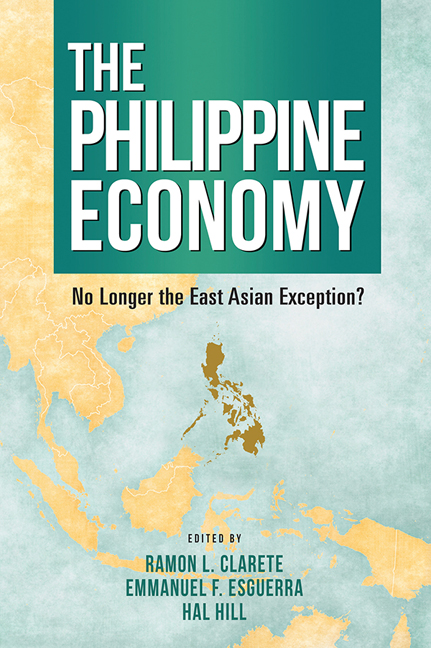Book contents
- Frontmatter
- Contents
- List of Figures
- List of Tables
- Foreword by Arsenio M. Balisacan
- Preface
- About the Contributors
- 1 The Philippine Economy: An Overview
- 2 Economic Growth and Poverty Reduction
- 3 Infrastructure and Urbanization
- 4 Education and Training
- 5 Universal Health Coverage, Health Security and Resilient Health Systems
- 6 Environmental Resources, Shocks and National Well-Being
- 7 Energy: Power Security and Competitiveness
- 8 Development Finance
- 9 Governance and Institutions
- Index
2 - Economic Growth and Poverty Reduction
Published online by Cambridge University Press: 12 February 2019
- Frontmatter
- Contents
- List of Figures
- List of Tables
- Foreword by Arsenio M. Balisacan
- Preface
- About the Contributors
- 1 The Philippine Economy: An Overview
- 2 Economic Growth and Poverty Reduction
- 3 Infrastructure and Urbanization
- 4 Education and Training
- 5 Universal Health Coverage, Health Security and Resilient Health Systems
- 6 Environmental Resources, Shocks and National Well-Being
- 7 Energy: Power Security and Competitiveness
- 8 Development Finance
- 9 Governance and Institutions
- Index
Summary
Introduction
The Philippine economy grew by 6.8 per cent in 2016, which is high by regional standards. The strong performance departs from its average growth of only 4.2 per cent since the 1960s. However, a quarter of the population remains poor, repeating its record in 2000, when it had as many poor despite a rate of growth of 6 per cent. Unlike its East Asian neighbours, the country has been weak in translating growth to lowering poverty (Balisacan and Fuwa 2004).
This chapter looks at the factors shaping growth and poverty in the Philippines. Studies have attributed significant gains in poverty eradication in East Asia to sustained robust growth (e.g., Dollar and Kraay 2002; World Bank 2006). The next section takes up the factors contributing to growth performance and examines how the current robust growth can be sustained. The third section focuses on the problem of the country's weak capacity of translating growth to poverty reduction. Apparently, high growth with less inequality reduces poverty faster (Bourguignon 2003; Fosu 2010). The chapter then tracks using an economy-wide model of the Philippines the per capita GDP and poverty trajectories of the country into the next twenty-five years under two growth and two income distribution scenarios. The last section states the study's key findings.
Factors Shaping Growth Performance
The Philippine economic growth in recent years has been robust by regional standards (Table 2.1): 6.8 per cent in 2016 and an average rate of 6.3 per cent from 2010 to 2016 (Figure 2.1). The performance departs significantly from its average of 4 per cent from 1961 to 2009. Since 2000 the average growth increased to 5.21 per cent per year, and could have been faster were it not for the global economic crisis in 2008.
Compared with selected East Asian countries (Table 2.1), the growth performance of the Philippines was markedly behind those of its neighbours in the 1980s and 1990s. In the 2000s, however, the country caught up with its Southeast Asian neighbours, and exceeded their growth in the last five years. The growth of the People's Republic of China (PRC), however, has remained the fastest since the 1980s.
- Type
- Chapter
- Information
- The Philippine EconomyNo Longer The East Asian Exception?, pp. 53 - 111Publisher: ISEAS–Yusof Ishak InstitutePrint publication year: 2018

